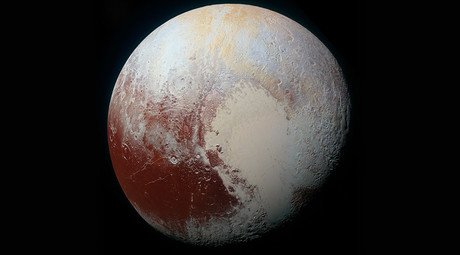Pluto’s painting: Dwarf planet uses methane to ‘graffiti’ its largest moon Charon

One year after NASA’s flyby of Pluto, scientists are still uncovering information about the mysterious dwarf planet – and now they’ve learned it’s a graffiti artist. A new study found that Pluto “spray paints” its largest moon, Charon, giving it a red cap.
The “paint” is actually made when Pluto releases colorless methane gas, which gets trapped in Charon's gravity. That gas accumulates and freezes into the moon’s north pole during its hundred year-long winters. When the pole finally gets sunlight, a chemical reaction takes place and turns the methane into red-colored molecules.
Those molecules, known as tholins, are the reason that photos of Charon tend to show the moon wearing a red cap.
“It’s almost like Pluto is a graffiti artist, spray-painting Charon’s poles with its escaping atmosphere, leaving planet-scale colored spots,” the study’s lead author, planetary scientist Will Grundy of the Lowell Observatory in Flagstaff, Arizona, told ABC News.
“This sort of thing might not be unusual among double planets, but we never had a close look at such a system until New Horizons flew through the Pluto system last year.”
Grundy also said the finding supports the idea that Pluto and Charon are a “double planet,” PBS NewsHour reported. Although most moons in our solar system are much smaller than their planets, Charon is almost the same size as Pluto, which leads to exchanges in surface materials and shifts in the center of mass for the entire planet. In fact, if Charon wasn’t already orbiting the dwarf planet, it could possibly be seen as its own planet.
Study co-author and New Horizons’ principal scientist Alan Stern said the findings could mean similar things are happening elsewhere.
“This study solves one of the greatest mysteries we found on Charon," Stern said in a statement. "It opens up the possibility that other small bodies in this faraway twilight zone known as the Kuiper Belt may be undergoing the same thing.”
The study specifically notes that Pluto's small moon, Nix, also has a reddish spot. However, it orbits farther from Pluto and is so small that such “spray painting” wouldn't be nearly as efficient.
The study, published in the journal Nature on Wednesday, comes 14 months after NASA's New Horizons spacecraft conducted a historic flyby of Pluto, sending back photos which provided scientists with their first glimpse of Charon's colorful ice cap. The finding was particularly notable because Charon had previously been thought to be completely gray.













